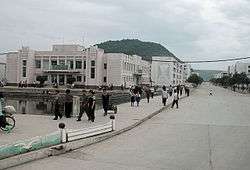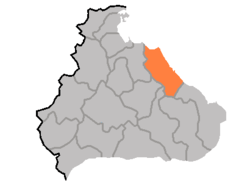Tongchon County
T'ongch'ŏn County is a kun, or county, in Kangwŏn province, North Korea. It abuts the Sea of Japan (East Sea of Korea) to the north and east. Famous people from T'ongch'ŏn include former Hyundai chairman Chung Ju-yung, who is believed to have been born there.
T'ongch'ŏn County 통천군 | |
|---|---|
| Korean transcription(s) | |
| • Chosŏn'gŭl | 통천군 |
| • Hancha | 通川郡 |
| • McCune-Reischauer | T'ongch'ŏn kun |
| • Revised Romanization | Tongcheon-gun |
 A view of downtown T'ongch'ŏn-ŭp, North Korea. | |
 Map of Kangwon showing the location of Tongchon | |
| Country | North Korea |
| Province | Kangwŏn Province |
| Administrative divisions | 1 ŭp, 30 ri |
| Population (1990 est.) | |
| • Total | 67,000 |
Administrative divisions
T'ongch'ŏn county is divided into 1 ŭp (town) and 30 ri (villages):
|
|
Physical features
The terrain is mountainous in the west, sloping down to the coastal plains (including the T'ongch'ŏn Plain and Hupkok Plain) in the east. The plains are used for rice cultivation. The area is prone to fog. As elsewhere along the Kangwŏn coast, there are various lagoons.
Economy
Due to the extensive plains, agriculture is a major local industry; in addition to rice, the county produces barley, wheat, oats, millet, maize, soybeans, and potatoes. Lumbering and fishing also play a role.
Tourism
The region has long been a popular destination due to the proximity of Mount Kŭmgang and, in recent years, tourists from South Korea have passed through the area in great numbers.
Transport
- Road
A highway runs along the coastline.
- Rail
T'ongch'ŏn county is served by T'ongch'ŏn Station and five other stations on the Kŭmgangsan Ch'ŏngnyŏn Line of the Korean State Railway.
External links
- (in Korean) In Korean language online encyclopedias:
